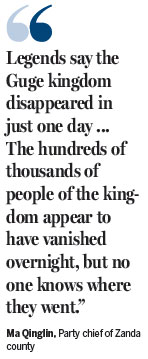|
The remains of the ancient Guge kingdom in Ngari prefecture in the Tibet autonomous region. Luo Wangshu / China Daily |
A landmark in history
The Guge kingdom was an important landmark in the history of Tibet. It was founded by Nyi Ma Mgon, the great-grandson of Langdarma, the last monarch of the Tibetan Empire, who rejected Buddhism in favor of the ancient Bon religion. When Langdarma was assassinated, Nyi Ma Mgon fled to the Ngari area, married the sister of a local ruler and later established the Guge kingdom.
He divided his territory into three parts and gave one-third to each of his sons. The second son inherited the Guge kingdom, which was conquered by the central government of Tibet under the leadership of the fifth Dalai Lama in the late 17th century.

"Legends say the Guge kingdom disappeared in just one day, but the story is still unclear. The hundreds of thousands of people of the kingdom appear to have vanished overnight, but no one knows where they went," said Ma Qinglin, Party chief of Zanda county. Historians say the kingdom was conquered quickly after a short, brutal battle.
The local people say a cave filled with the remains of soldiers and residents is hidden at the base of the fortress, which is believed to be the place where the last Guge king surrendered as he watched his people being massacred.
Bringing people 'home'
Kalzang Rinzin's "home" is pyramid shaped and numerous tunnels and caves have been carved into the soft rock, which rises about 300 meters above the clay forest.
"The common people lived at the base, the monks and officials lived in the middle and the royal family resided at the very top in their own summer palace," Kalzang said, adding that legend says the last queen committed suicide by leaping from the top of the structure when the kingdom was conquered.
Kalzang Rinzin and his family were once the only people living in the fortress, and it took hours to walk through the clay forest to the nearest village to buy groceries. He has played many roles at the fortress, from tour guide to guard, and is famous locally because he has never been afraid to walk through the 56-hectare "forest" in the dark.
He now is head of the local tourism bureau and oversees all aspects of the administration, including training more guides to introduce the Guge kingdom to a greater number of visitors. At present, the ruins receive about 60 or 70 tourists a day.
One visitor, Gang Shou-sheng, a history teacher from Shandong province, was unable to express his feelings after he visited the ruins. "I don't know how to explain my impressions of this ancient kingdom. I feel that if I say anything, I will only belittle this magnificent edifice," he said.
Palden Nyima contributed to this story.
Contact the writers through luowangshu@chinadaily.com.cn